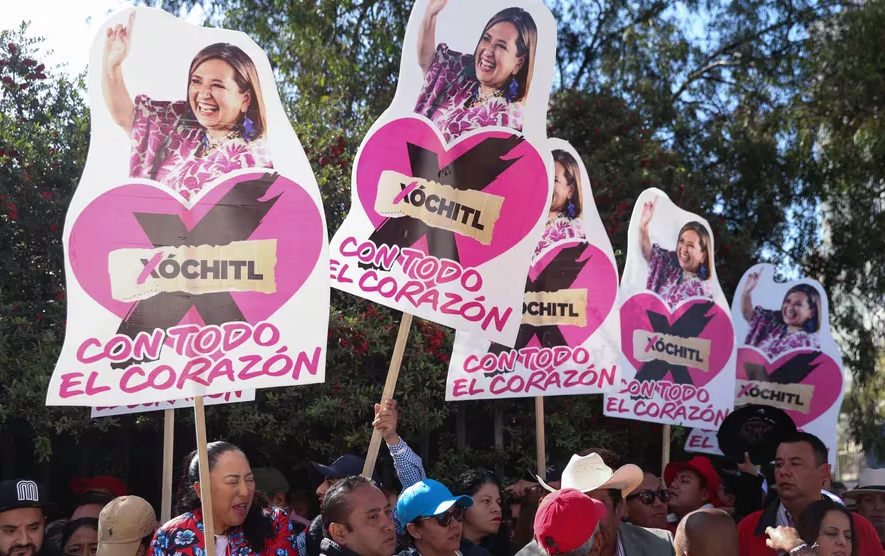On March 1st, the campaigns for the presidency of Mexico officially began. I emphasize the word officially because those of us who closely follow Mexican politics know that the presidential race began last summer with pre-campaigns that were not such and, in short, with actions that flagrantly violated the electoral laws in force. Since then, a good part of the media agenda has been given to the task of covering the activities of those who are now formally contenders for the presidency of the republic: Claudia Sheinbaum, Xóchitl Gálvez and Jorge Álvarez Máynez.
At the Universidad Autónoma de San Luis Potosí we set up a media monitoring laboratory to organize and systematize a database of journalistic information on the presidential campaigns published by six national media (El Universal, Reformá, La Jornada, El Sol de México, Milenio y Excélsior) and five international media (El País, DW, France 24, The New York Times and BBC). The objective is to compile useful information for scholars of electoral processes, in any of their aspects, as well as for the general public.
After the first month of campaigning, the laboratory team identified 1777 news pieces related to the current electoral process, with the newspaper El Universal standing out in its coverage with 39 percent of the entire news universe observed, followed far behind by La Jornada (17%) and Reforma (16%). In the sample of international media, we observe that Mexican elections do not stand out (at least so far) among the main topics of the Spanish editions of the selected portals, which during March paid more attention to the Venezuelan elections and the political crisis in Haiti.
Regarding the coverage by candidates, the results show that the pro-government Claudia Sheinbaum is the one who has the most news (44%) followed by Xóchitl Gálvez (36%) and Jorge Álvarez Máynez (19%). At this point, it is important to highlight that the figure of President López Obrador has relevant journalistic weight since newspapers have reported his constant interventions in the electoral process, despite his legal restrictions. The laboratory identified 96 articles that alluded to the president’s pronouncements regarding the ongoing campaigns, which would represent 12 percent of the total number of news items that have talked exclusively about the candidacies. On the other hand, it is striking that the National Electoral Institute, as arbiter of the race, has received more coverage in terms of absolute number of articles than the candidate trailing in the polls.
Another aspect that is worth considering is that of campaign issues. It is well known that in most modern democracies, electoral campaigns usually revolve around an issue that articulates the axis of the political discussion for power. In the Mexican case, unlike the processes closer in time, this still does not seem to be very clear. That is to say, although the major national problems are identified (such as insecurity, corruption or health), the press releases are very heterogeneous in terms of the campaign proposals themselves, either because the newspapers focus strictly on the description of the campaign acts, or because the candidates have leaned more to the articulation of narratives than to the generation of proposals. In this regard, it is noteworthy, for example, that with regard to the youth agenda, a very important sector of the electorate, the press only includes eight articles on the offer for them, which represents a meager 0.45 percent of the newspaper coverage.
Perhaps the most outstanding aspect of this first month of coverage is that the Mexican campaign seems to be characterized by its high level of political and editorial opinion. In this category we found 405 pieces, representing one out of every five publications in the selected media. Among the universe of opinion columns observed, the laboratory detected two things that we consider significant to highlight: a) that in the proportion of columnists there is a difference of 2.6 pieces written by men for every woman; and b) that in the top 10 of opinion writers there is only one woman. This reflects, in a way, the stony trend of masculinization of politics in which men monopolize the space, in this case, in political commentary.
Finally, another data worth highlighting has to do with the production of political cartoons in which it stands out that a little more than half of the cartoons published during the month of March (54%) were published by moneros (cartoonists) related to the 4T such as Hernández or El Fisgón.
In summary, this first month of the campaign shows that the news flow of the campaign is very broad, although not so much at the international level, that the coverage is very heterogeneous in terms of topics, that there is a strong propensity for political opinion and editorial writing and, in this sense, there is a marked predominance of male pens over female ones.
The complete newsletter is available at: https://www.uaslp.mx/Paginas/General/6810.
*Translated by Micaela Machado Rodrigues from the original in Spanish.











